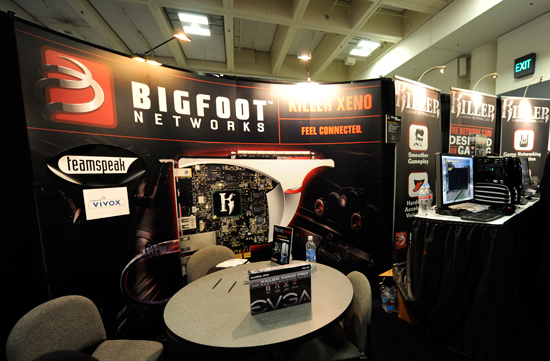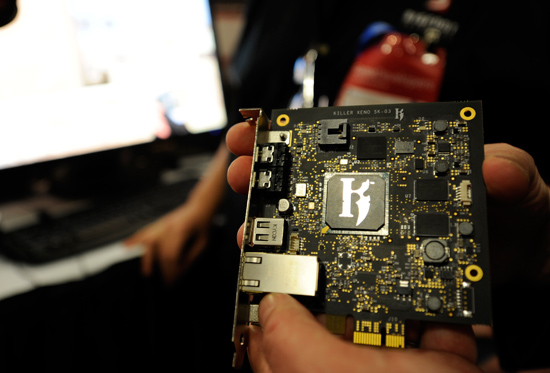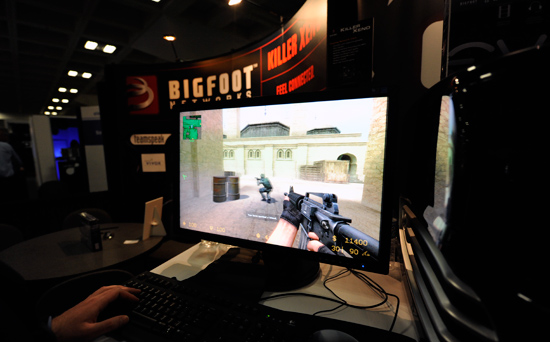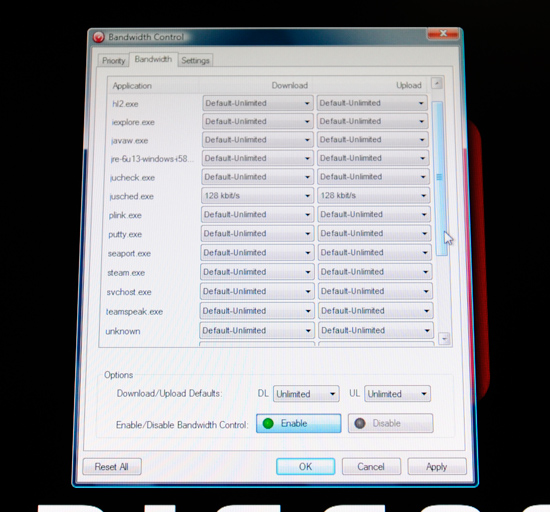Nintendo's Development Secrets, Cloud Gaming & new Killer NIC - GDC '09
by Anand Lal Shimpi & Derek Wilson on March 26, 2009 12:00 AM EST- Posted in
- Trade Shows
Bigfoot is Back: Killer Xeno NIC
You all remember Bigfoot Networks, right? The makers of the Killer NIC? They’re back with a cheaper, updated product: the Killer Xeno.

The Killer Xeno is a network card with an on-board processor, memory and lightweight Linux OS. It serves as a packet accelerator and voice/UDP offload processor for your PC. The idea is that the Windows audio and networking stacks are horribly inefficient and optimized for file transfers, not low latency gaming. The Killer Xeno bypasses the Windows audio/networking stacks and uses its own lightweight stacks to handle all voice chat/networking requests, theoretically translating into lower pings while gaming with voice chat enabled.

The new Killer NIC adds support for voice chat, a feature the original didn't have
We’ll be looking at the Killer Xeno in the not too distant future. Despite there being demos at the booth, none of them were the necessary Killer Xeno vs. No Killer Xeno tests to determine the usefulness of such a thing. We’ll put the card through its paces soon enough.

Counterstrike was the test of choice. Unfortunately there was no reference point for the demo.

The Killer Xeno software includes an application that will let you throttle bandwidth to running processes/applications. The utility can also serve as an automatic alert/defender against undesired outbound or incoming network connections.
The Xeno will ship next month starting at $130.










38 Comments
View All Comments
wilkinb - Thursday, March 26, 2009 - link
in woW latency can be a big deal...Stop casts in pvp or boss fights are a lot harder when you have high ping times and the cast times are short....
Also timing CD's right time not be on shot...
Sure if you are just doing easy content or dont care about arenas then it doesnt matter... but the same can be said about FPS...
Also people keep saying wow isnt prashically intensive.. this again is true when you stand by your self... when you are on say a WG battle ground with say 160 other players adn all their spell effects... there are a lot of polygons... It runs slower then crysis for example.
MOO's have to deal with more scaling issues then FPS.
MMO's have the issue f
wilkinb - Thursday, March 26, 2009 - link
no idea what happned to some of that text :(wtb edit.
randomname - Thursday, March 26, 2009 - link
"I'm sure the video latency will be at least a second."In Dean Takahashi's article:
"A packet can make an entire round trip in 80 milliseconds, a very short amount of time compared to other Internet traffic that travels through hardware that either compresses or decompresses the data."
I'm assuming that 80 ms has all the essential stages included. Which would be supported by Anand's claim that Bioshock felt like Bioshock.
Nevertheless, lag, reliability and bandwidth are probably the only obstacles here. All of which can be further improved. Bandwidth-wise, once you get to Blu-Ray -quality 40/48 Mbps, or at least when you get to 1080p60 4:4:4 -quality, additional bandwidth won't get you anything, really. On the server side, you would only have to buy a fraction of the number of consoles/computing hardware compared to every user buying one. And if you can do it with games, you can do it with all programs and media.
SSDMaster - Thursday, March 26, 2009 - link
80ms? Okay, wonderful. I have to wait .08 Seconds till I can move my cross hairs over someone's head which is only going to be in that specific location for another .02 Seconds.FPS's are too fast paced for this... Especially UT 2004 types.
Maybe you could play a horrendously slow paced FPS like Halo or something.
Also, the US internet backbone just cannot handle this kind of streaming. Comcast gives me a 30mb connection for about 7 minutes. Then they cap it back to whatever I "really" have, which is a 6mb connection. Which "should" be enough unless everyone starts using onLive... Then I'm sure Comcast won't even be able to give me 6mb.
My last point. Internet packets don't always arrive on time or in order, its not like you have this one internet (pipe) to your computer. Think of a stream full of rocks, and your packets (water) are taking tons of different paths, all around these rocks.
That's really not a good enough illustration but I think you guys get the point. If you have a router between you and onLive server's which is bogged down but still working; then your connections going to suck. Not all routers prioritize packets.
Modeverything - Thursday, March 26, 2009 - link
I think one solution to this could be to use UDP instead of TCP.Today's networks are not the ones of a decade ago when packet verification was needed. Packets rarely get lost anymore, and if you lose a single packet, big deal, you probably won't notice anyway.
If OnLive were setup to use UDP transmission, I think it would work.
overzealot - Friday, March 27, 2009 - link
It's a latency-critical app, they're definately going to use UDP, possibly with a layer of RTP(or similar protocol)andrihb - Thursday, March 26, 2009 - link
Think of them as a series of...Calin - Thursday, March 26, 2009 - link
Latency might not be a big deal in World of Warcraft - but remember that people balk at the idea of TFT monitors showing the image from 3-5 frames back - that's less than a tenth of a second. If you're talking about Internet-enabled gaming, you should consider the ping response time you get from a server when you're streaming something (from the same server, probably). Let's say ping to a game server while streaming high quality video.The bandwidth really needs to increase for this, and the latency needs to go down.
As for adaptive quality based on usable bandwidth, you don't know when you're reaching your bandwidth, you only know when you're surpassing it, so that makes the game stutter (too low a bandwidth = lost packets), then go sometime in low quality mode, and then go again in high quality mode. For high quality games, the server would need the equivalent of a high-performance recent-generation video card and CPU for every gamer out there, and the hardware or CPU to compress that stream (video and audio)
It will probably happen, but it's a long time into future